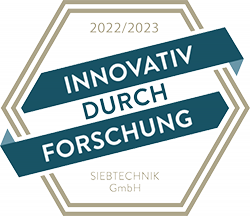Do you have a question? We will be happy to give you an answer. If you can’t find your question here, please contact us! Details can be found on the contact page.
Probenmaterial
It can be used for dry materials, regardless of their shape (regular shape, porous or non-porous, powdery, granular).
The grain size is irrelevant for the measurement, but the material must not exceed the size of the measuring cup.
Gas pycnometers are generally used to measure the skeletal density of dry materials. In principle, it is also possible to determine the density of liquids and pastes.
For unadulterated measurements, the sample must only have a negligibly low vapor pressure, as the gases and vapors released during the measurement influence the equilibrium pressures.
Yes, because as the title of DIN EN ISO 1183-3 (Determination of the density of non-foamed plastics – Part 3: Gas pycnometer method) suggests, this is an analysis using a gas pycnometer, which is what the BULKINSPECTOR is.
DIN 60 (Plastics – Determination of the apparent density of molding compounds which can flow through a standardized funnel (bulk density)) is a standard for determining the bulk density, which cannot be determined with a pycnometer.
Probenaufgabe
The standard version of the BULKINSPECTOR has measuring beakers in the size 130 / 65 / 10 cm³
130ml -> Ø57mm x53mm (not cylindrical), sample diameter max. 40mm
65ml -> Ø47mm x41mm (not cylindrical), sample diameter max. 40mm
10ml -> Ø25mm x22mm (not cylindrical), sample diameter max. 20mm
The BULKINSPECTOR was developed for the automatic determination of density and can therefore be integrated into existing processes for on-line analysis. The type of sampling from bulk or piece goods and the feed to the pycnometer must be planned for each individual case. With our sampling know-how, we are happy to assist you with planning.
Sample magazines with 25 / 50 storage spaces are optionally available (see Equipment & Accessories for Screening Machines)
Basically yes, but these must not exceed the maximum dimensions of the 130 cm³ measuring cup.
Messung (Methode)
Weight, volume and density of the sample. Also the measurement uncertainty of repeat measurements.
Normally, the measuring gas used in gas pycnometers is an inert gas, e.g. helium, which does not react with solids (i.e. reacts, is adsorbed) and whose atom is so small that it also penetrates porous material. Depending on the purpose of the measurement, however, other gases or oxygen can also be used.
0 … 510 g ± 0.0001 g.
Measuring temperatures between 15 and 35°C can be set.
The measurement uncertainty is ± 0.02%.
The analysis time for a full cycle depends on the type of sample, the size of the sample container, the sample gas used and the number of repeat measurements. Therefore, the duration of approx. 3 – 6 minutes can only be given as a guideline.
Technische Daten
The BULKINSPECTOR has the following dimensions (width x depth x height) 1100 x 675 x 855 mm.
The weight is 190 kg.
The temperature of the appliance is controlled by Peltier elements.
German, English, Portuguese, Italian, Spanish, Dutch, Russian, French.
Anschlüsse, Schnittstellen & Datenübertragung
AC 110 V/16 A/60 Hz, AC 230 V/10 A/50 Hz
No, the machine sets up its own WLAN for operation via tablet.
The device has a network interface (LAN or RJ45) and has its own WLAN (WiFi) network.
If the PC has a Bluetooth receiver, you can send the measurement results via the Bluetooth of the tablet supplied.
Of course, the BULKINSPECTOR can also be used in the USA. It can be operated with AC 110 V/16 A/60 Hz, AC 230 V/10 A/50 Hz.
Yes, the BULKINSPECTOR can be operated from any computer in the same network via the browser. No additional software is required.
Wartung & Service
You can test the BULKINSPECTOR in our laboratory and test center in Mülheim an der Ruhr.
The measuring beakers must be cleaned manually at regular intervals. How long these intervals are depends on the sample material.
You can contact us at any time using the form available on the website. In addition, our support team will be happy to help you during our normal business hours. All information can be found on our contact page.
The main maintenance work on the BULKINSPECTOR is as follows:
Regular cleaning of the measuring beakers.
Regular recalibration with a calibration sphere, which can also be carried out automatically by the BULKINSPECTOR.
Replacing the ultra-fine filter in the gas line, especially if ultra-fine particles are measured frequently
The scope of the required wear and spare parts depends on the material to be analyzed and the operating conditions and can only be determined individually.
Ausstattung & Zubehör
The tablet for using the BULKINSPECTOR app control is of course included.
The following accessories are available for the BULKINSPECTOR:
130/65/10 cm³ measuring beakers
Sample magazine with 25/50 sample containers
Base frames with/without sound insulation
Calibration balls
Vacuum cleaner
Compressor
Adapter set for connecting a larger waste container
Sampling devices for integrating the BULKINSPECTOR as an on-line measuring device in running processes.
Grundlagen & Begriffserklärungen
The BULKINSPECTOR is the only pycnometer on the market in which the measuring cup is automatically inserted into the measuring cell by a handling device. In addition, the sample is weighed by a scale integrated in the BULKINSPECTOR, so that no additional handling by the operator is necessary.
This also makes it possible to connect a sample magazine upstream of the device or to integrate it into the on-line monitoring of processes.
The BULKINSPECTOR is a gas pycnometer. It can be used to determine the density (skeletal density) of solids, porous and bulk materials, including powders, with high precision.
Gas pycnometers are generally based on the solids to be measured displacing their volume of test gas in a sample chamber. Helium is usually used as the test gas as it does not interact (i.e. react or adsorb) with solids and the atom is so small that it penetrates even porous material.
Our BULKINSPECTOR is a constant volume gas pycnometer.
This type of measurement is the most widely used and is also mentioned directly as a method in various standards and pharmacopoeias.
After the material sample has been placed in a measuring cup, it is placed in the measuring cell via a handling device, where the volume of the sample is determined according to the selected presettings.
After the volume has been determined several times, the handling device takes over the further transport to the scales to determine the sample mass.
Once the mass of the sample is known, the density of the solid can be calculated. This is also known as the true density.
Finally, the handling device removes the measuring cup and takes the measured material sample to the emptying device. There, the measuring cup is additionally cleaned with compressed air and is then ready for the next sample.
Skeletal density, also known as pure density, absolute or true density, refers to the density of the material part of a body in any state of aggregation, i.e. without taking into account the volume of any cavities it may contain. In the case of porous solids, the pure density is determined by crushing and grinding the material until its particles no longer contain any pores (see also tapped density). The counterpart to the pure density of porous solids is the bulk density, which does include the pore volume. Gas pycnometers with helium as the test gas are used as a good approximation for determining the true density.
In the case of aggregates, the pure density results from weighing and extrapolation during grain analysis. The counterpart to the pure density of piles is the bulk density.
Source: This article is licensed under the GNU Free Documentation License. It uses material from the Wikipedia article “Reindichte”. A list of authors is available in Wikipedia.
The skeletal density or pure density, absolute density or true density refers to the density without taking into account the volume of any cavities it contains.
Bulk density, on the other hand, is the density of a bulk material and a continuous fluid that fills the cavities between the particles. This fluid can also be air. The individual components must not dissolve into each other.
Source: This article is based on articles from the free encyclopedia Wikipedia and is licensed under the GNU Free Documentation License. A list of authors is available on Wikipedia.
Tapped density (synonym: vibration density) describes the density of a heap (solid) already compacted by tamping or vibration in comparison to its bulk density.
Source: This article is based on various articles from the free encyclopedia Wikipedia and is licensed under the GNU Free Documentation License. A list of authors can be found in Wikipedia.
Bulk density, also called apparent or geometric density or density, is the density of a porous solid based on the volume including the pore spaces.
Source: This article is based on various articles from the free encyclopedia Wikipedia and is licensed under the GNU Free Documentation License. A list of authors can be found in Wikipedia.
If the personnel costs including ancillary costs for a laboratory technician are estimated at approx. 65,000 €/year, the BULKINSPECTOR will pay for itself after just one year if the laboratory technician is completely relieved of the measuring activities. If the laboratory technician is only relieved of part-time work, the amortization period is 2 years.

SIEBTECHNIK TEMA on site
Find the right contact for your region.
How can we help you?
We have the right solution for every task. And if not, we’ll work with you to find one. Get in touch with us!
Our specialists will be happy to advise you individually on site or remotely, and are available to answer any questions you may have. Send us a message using our


